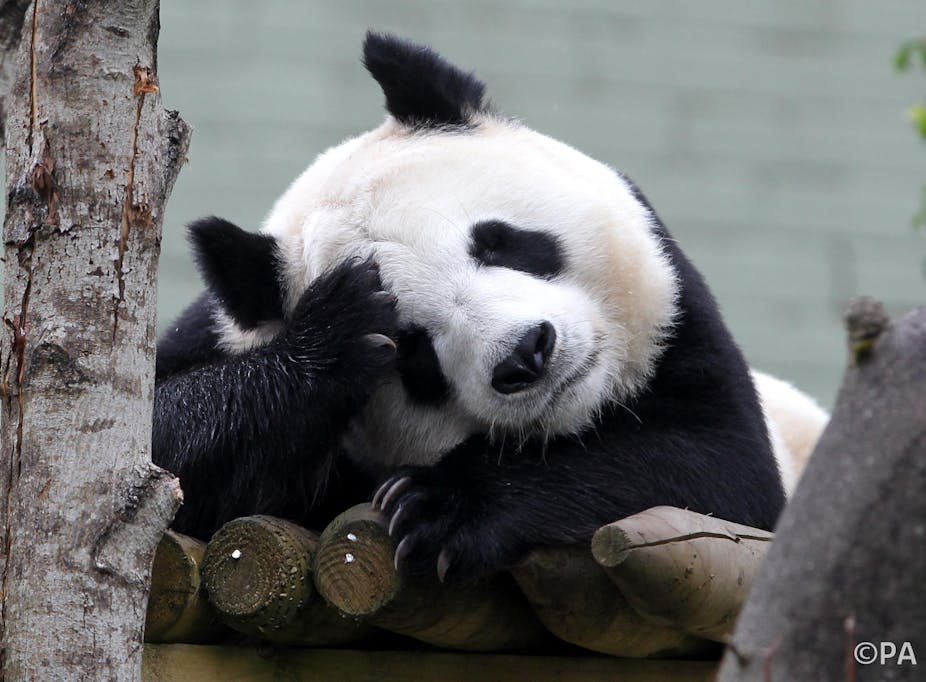When the Chinese authorities in Chengdu showed off their 14 giant panda cubs last week, it again raised questions about the role of panda breeding in zoos outside China, and whether it is a help or hindrance to their conservation in the wild.
From one perspective this practice isn’t even about panda conservation, but is nowadays linked more to commerce and trade agreements between China and the countries concerned - so-called panda diplomacy. It’s also been suggested that some of the very large amounts of money needed to loan pandas from the Chinese government, money ostensibly used for panda conservation, may not in fact fund panda conservation at all.
These were the sort of issues that brought researchers and zoologists and biologists (myself included) to a symposium at Edinburgh Zoo last month, to hear the current state-of-the-art in panda conservation, and to help the Royal Zoological Society of Scotland develop a research program to help pandas in the future, both in captivity and in the wild.
Despite the fact that this is one of the most heavily researched endangered species in the world, the elusive nature and peculiar lifestyle of wild pandas mean there is still a lot to learn about China’s “bear-cat” (the literal translation of the Chinese name, 熊貓 or xióng māo).
The symposium brought together some of China’s top panda experts, scientists and zoo curators from the US, UK and Germany, and researchers from Scotland who have been studying Edinburgh Zoo’s captive pair Tian Tian and Yang Guang since they arrived in 2011. So as the world has watched and waited (and waited) for news of whether Tian Tian will be the first captive panda to give birth in the UK, there were serious discussions about how the Society could use its resources to prevent the species going extinct in the wild.
In the last two years, Chinese authorities have been conducting the 4th National Survey to attempt to document the remaining wild panda population. Estimated at around 1,600 in 2003, it may have increased following stringent protection measures and improvements in the way pandas are counted – including DNA profiling.
One issue raised was need for better means of assessing the success or failure of efforts to reconnect the areas of panda habitat, areas that are divided by ever-expanding development by China’s human population. In fact pandas do not always stay in their bamboo forests as we might believe. In 2005 a female panda was found in the city of Dujiangyan, sitting in a tree next to a major road. Those who saw her were struck by her agility, speed and ability to evade capture: wild giant pandas are far from the sluggish chewing machines their captive relatives are sometimes portrayed as.
If, as seems possible, panda populations are slowly rising, the challenge is how to enable them to move between patches of surviving habitat near human settlements, and how to monitor them when they disperse. Ultimately it will be connections between reserves that will enable the species to occupy more of its former range.
But to create these corridors so that they are used, we need to know a lot more about how individual pandas use their existing habitat, and what forces them out into less familiar areas. The availability of old growth forest to provide secure and stable tree holes for females to give birth, and the correct balance of bacterial gut flora needed for this unusual bear to process its bamboo diet in all seasons are also important areas that need research.
For captive breeding programs the challenge remains how, or even whether, it is possible to predict whether a male and female housed together will breed. Do male pandas whose genes come from the northern part of their natural range (Shaanxi province) fancy southern females from the south of Sichuan, for example? And while artificial insemination is already used to impregnate females (as is the case with Tian Tian), could other forms of reproductive technology be used for better breeding success? Or should we simply encourage pandas to mate naturally, as they do in some zoos?
One thing seems clear, Edinburgh is committed to help panda conservation for the foreseeable future (their pandas are on loan for ten years), which is just as well because although Tian Tian’s hormone profiles look promising (I could tell you the details, but I would have to shoot you afterwards), a birth within the next few weeks is far from assured. And some zoos have waited almost a decade for the patter of tiny paws, with no success.

